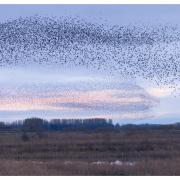The Yorkshire Dales is emerging as a nationally, and perhaps internationally, important area for bats, as Terry Fletcher discovers
When it comes to picking a winter hideaway from the snow and cold most of us dream of a Caribbean island or perhaps the Canaries but for countless thousands of bats their dream hotel is deep beneath the Yorkshire Dales.
Researchers based at Leeds University are slowly teasing out the details of the bat’s life cycle and one surprise has been unearthing more and more colonies hibernating in the chambers and tunnels that riddle the limestone hills.
Many have only recently been discovered thanks to new technology able to detect their movements and film them in the pitch darkness deep underground.
The reason they have remained hidden for so long, even from keen cavers, is that unlike the popular image of bats sleeping by hanging upside down from the roof, the five main species that favour the Dales – Natterer’s, Daubenton’s, Brandt’s, whiskered and long-eared – much prefer to wriggle deep into tiny crevices to sleep.
Until the latest research was published the disappearance of large numbers of bats each autumn led some scientists to believe that they migrated like birds, a theory supported by evidence from the United States and Europe which showed bats travelling over 1,000km (625miles).
Dave Hodgson, a caver and biologist, who has spent half a century studying the creatures that live deep underground, said: ‘It was all a bit of a mystery because the bats can be incredibly difficult to find. I began recording what I found in caves in 1956 but never saw a bat there until the 1960s. You could go into a cave where we now know there are five thousand bats yet not find a single one of them. But now the equipment is so sophisticated it is incredible what we are discovering.’
Prof John Altringham, who is leading the team, said that thanks to the new information the Dales, with almost two thousand known cave entrances and systems, were emerging as a nationally, and perhaps internationally, important area for bats.
Females raise their young in summer nursery colonies but in early autumn it is now known they fly to swarming sites. These are caves where hundreds of bats chase each other in spectacular aerial displays, probably to attract mates. On any one night hundreds of bats – mostly males – may be present and over the breeding season thousands of individual animals may visit the most important sites.
But as their favoured food supply of insects dwindles the bats prove themselves to be formidable cavers, flying deep into the systems using their echolocation system to navigate deep shafts, and skim through narrow bedding planes and make their way through boulder chokes. Deep underground with cool, stable temperatures they slow down their metabolism until a bat can survive the entire winter on just two grammes of stored body fat. In the spring they re-emerge from hiding.
Researchers are now working on linked studies as far afield as Ireland, France, Germany and Spain but it is already clear that the bats and the dark caverns of the Dales still have many more secrets to give up.


























